Revising programs creates a new ‘in revision’ version that can be compared to the published program. This preserves an audit trail and makes significant changes visible for stakeholder review and reporting. Some examples of significant changes prompting a revision include:
-
Changing Program Learning Outcomes (PLOs): Adding, removing, or significantly editing PLOs requires a revision, especially if those outcomes are part of a curriculum map or are being assessed.
-
Modifying Curriculum Mapping: Adding or removing courses, mapping outcomes to different courses, or changing relationships to institutional or accreditor standards.
-
Altering Assessment Structure: Reconfiguring the way data is collected, changing performance indicators, or updating the proficiency scale if it is not locked at a higher level of the Organizational Hierarchy. Learn more about locking platform settings.
-
Making Substantial Structural Changes: Updates that affect the foundational structure of the program and its alignment to reporting or assessment (e.g., adding/removing educational experiences).
-
Compliance or Accreditation Updates: Revising the program to meet new accreditation standards, institutional goals, or regulatory requirements.
-
Version Control Needs: Any changes that require tracking differences over time, maintaining a revision log, or auditing for accreditation.
Editing vs. Revising
|
Editing |
Edits are allowed in published programs. They are retroactive and will be applied to all historical versions of a program. In general, edits should be reserved for minor, non-substantive changes to a program. |
|
Revising |
Revisions create a new version of the program. Revisions are not retroactive, and historical versions of the program will be retained. Create a new version of the program when making substantive changes to outcomes, program structure, or curriculum. Learn more about revising programs. |
Program Revision Impacts
-
Revisions to programs can alter which version is used in assessments, data collections, and reporting. If assessments or data collections are in progress or pending, they can be updated to the new version or remain aligned to the old version.
-
Existing assessments tied to the previous program version will keep their assignment links unless they are explicitly excluded from the update during the publish step.
-
-
Updating courses within a program often requires aligning the program's educational experiences with the latest version of the course. If not updated, assessments will reference the previous course version, which may impact reporting and learning outcome tracking.
-
New program versions will reflect updates in curriculum mapping and PLOs; previous program versions remain unchanged for historical consistency. However, bulk changes to Learning Outcomes can break curriculum maps and may require remapping.
-
Downstream data impacts may require review or coordination with in-progress terms, sections, or data collections.
Program Versioning
When a program is revised, a new version is created with each revision to maintain historical data within the platform. Programs in In Revision status will display indented beneath the associated version in Published status. Clicking the name of a program (1) will navigate to the Program Homepage; clicking Manage Revision (2) will navigate to the homepage of the most recently revised version.
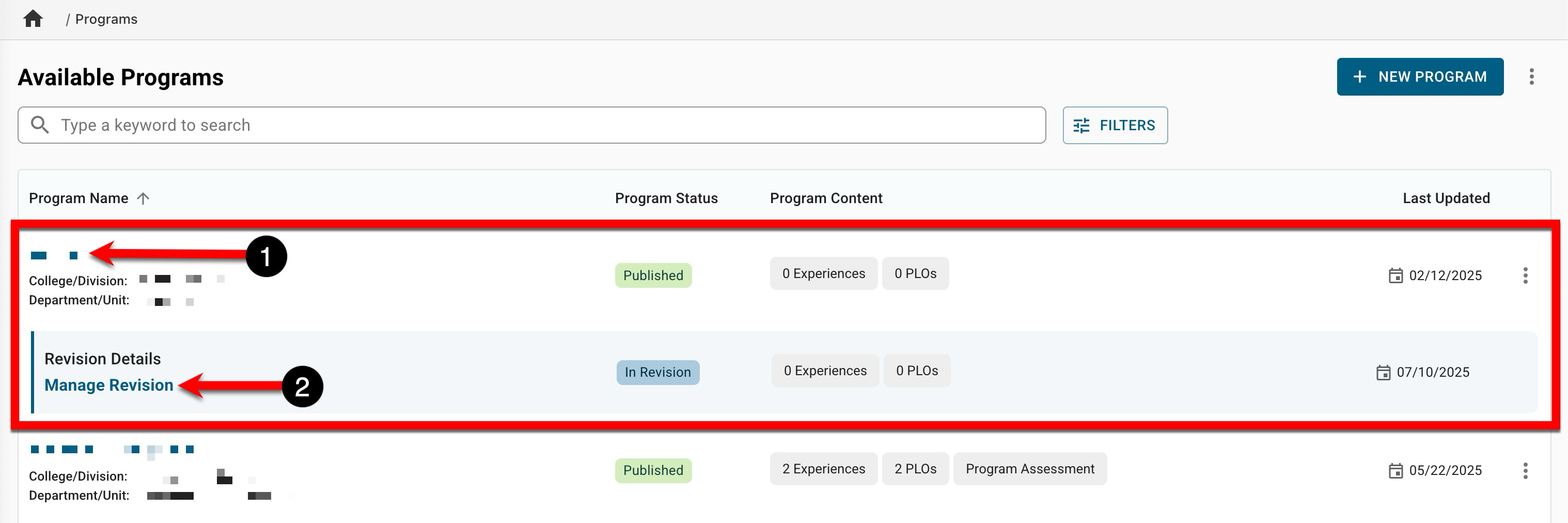
If an attempt is made to edit a published program while an in-progress revision is underway, the option to access and make changes to the revision (1) or continue editing the program for minor changes (2) is available. Learn more about editing programs.
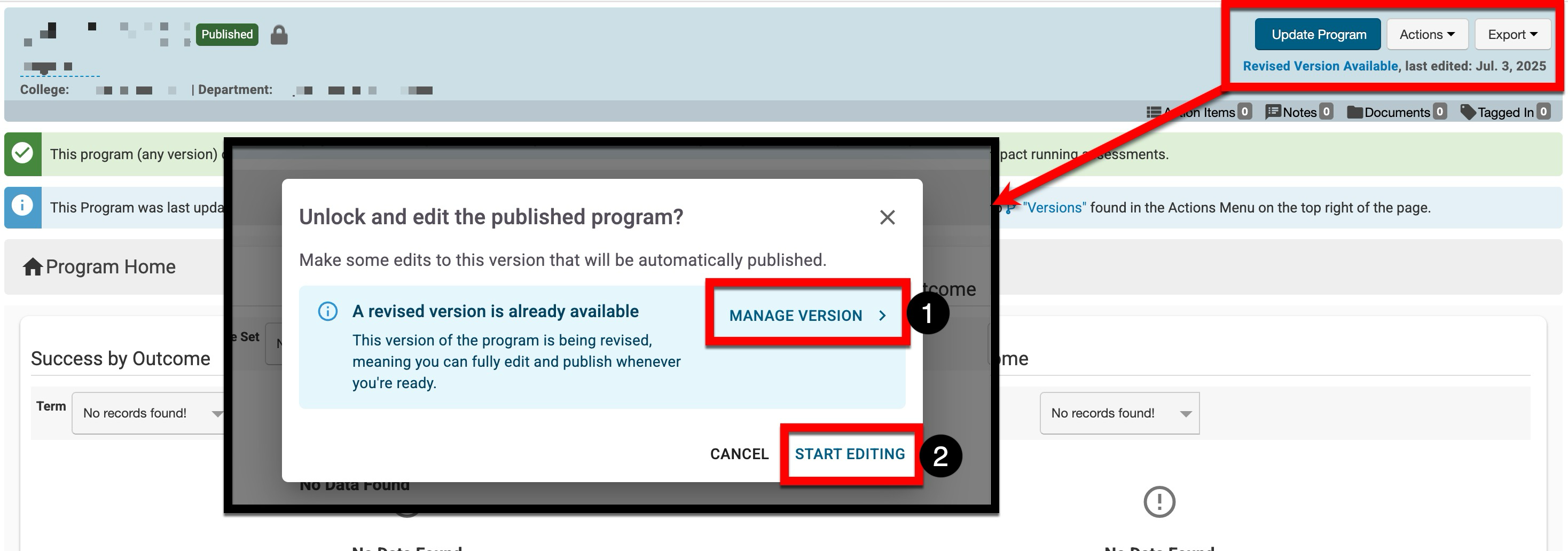
Program versions can be reviewed by accessing the Manage Versions page. The program code and version(s) are displayed (1), and clicking Manage (2) will navigate to the homepage for that version. The versions page can be exported to PDF format or printed (3).
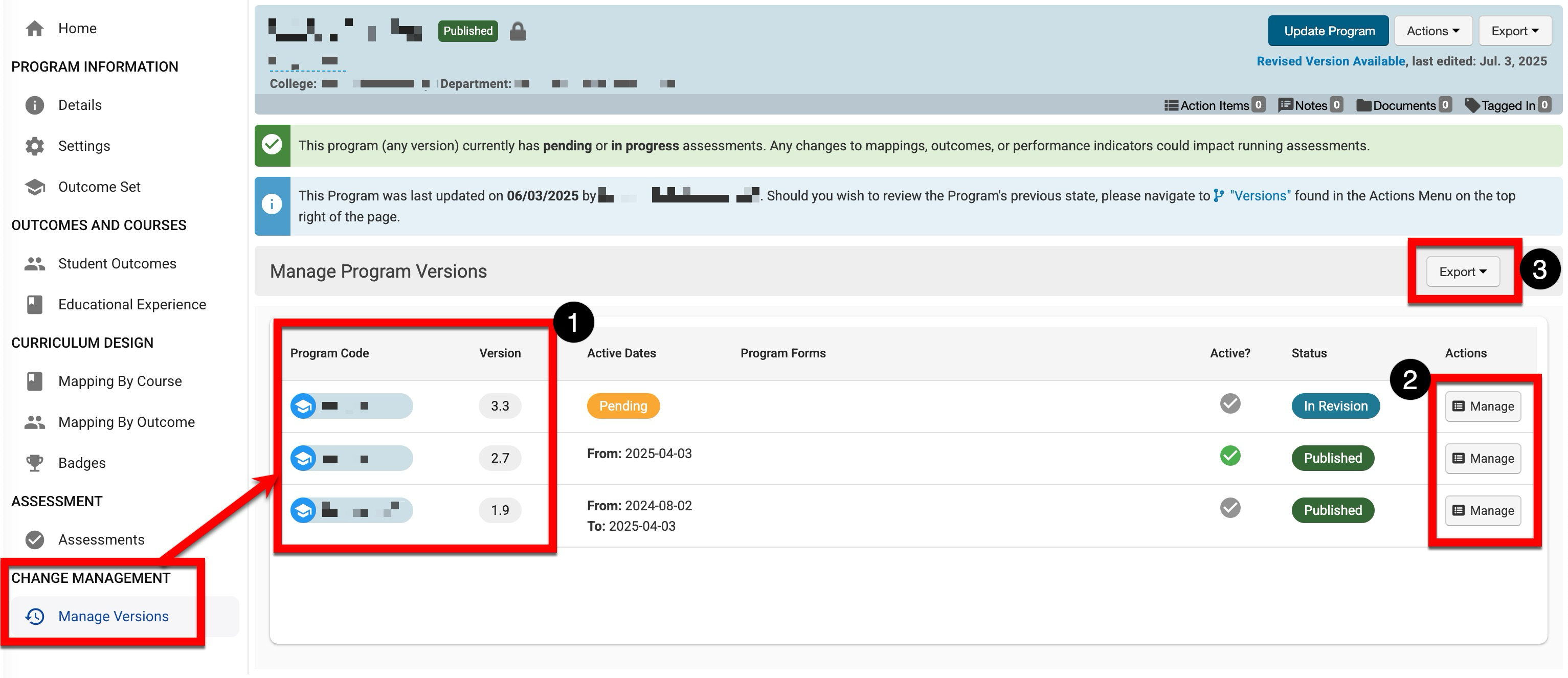
Considerations
-
Course Versioning: Make sure all relevant courses are in their most up-to-date published version.
-
Confirm Permissions and Roles: Permissions to create, publish, edit, or revise programs depend on program settings and the Organizational Hierarchy. Roles such as Course Section Director or Course Coordinator do not have permission to create programs, and access must be granted on the user’s account and mapped to the correct program or administrative unit to edit or revise a program. When disabled, no user role (including Institution Admins) will have permissions to create programs; program editing/revising can still be performed by users with sufficient role-based access. When enabled, user roles included in the Program Creation Roles(s) field will have permissions to create, publish, and edit or revise programs:
-
Institution Admin: Full platform-wide permissions to create, edit, revise, and publish programs.
-
College or Department Admin: Can create and edit programs associated with their assigned college(s)/department(s).
-
Program Coordinator: Can create and edit programs only if this ability is turned on in program settings. When enabled, the coordinator must also be linked to the relevant program or organizational unit.
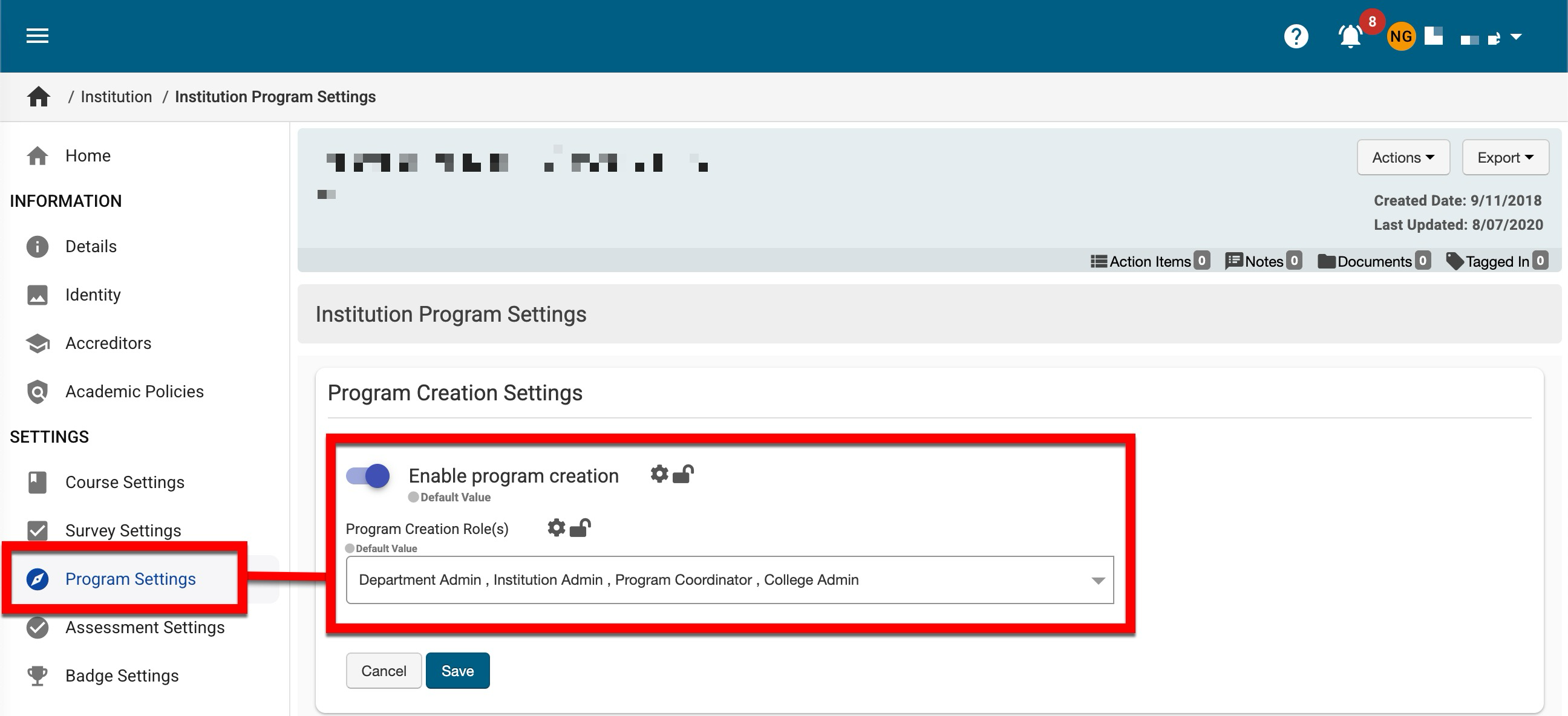
-
-
Assessment/Survey Timing: Consider timing the changes outside of active assessment or data collection periods to minimize complexity and ensure a smooth implementation. Changes may necessitate decisions on whether to carry open assessments forward or leave them unchanged.
-
Program Learning Outcomes: Editing or deleting learning outcomes can have significant impacts on curriculum mapping and reporting, and may require remapping.
-
Stakeholder Communication: Notify affected faculty, program coordinators, and admins before major revisions.
Best Practices
-
Always review and update curriculum maps after program revisions to ensure alignment across courses, PLOs, and assessments.
-
Communicate upcoming revisions with stakeholders and consider running them during assessment/curriculum planning cycles.
-
Double-check which assessments, surveys, or data collections will be impacted. Make careful choices when prompted to align or migrate existing ones during publishing.
-
Develop a regular review and revision schedule (e.g., annually or on a cycle) for programs to maintain consistency.
-
Evaluate downstream reporting and analytics—ensure any required curriculum and outcome mapping is preserved and accurate post-revision.
-
Communicate with stakeholders throughout the creation process, especially before making significant changes or publishing a program. Notify relevant parties of substantive revisions.
-
Utilize platform features, such as revision logs and version comparisons, to track changes, review updates, and maintain transparency. Document the revision cycle for audit and reporting purposes.
How to Revise a Program
-
Navigate to the Program Homepage and click Update Program.

-
When prompted, select the create a new version and publish later option.
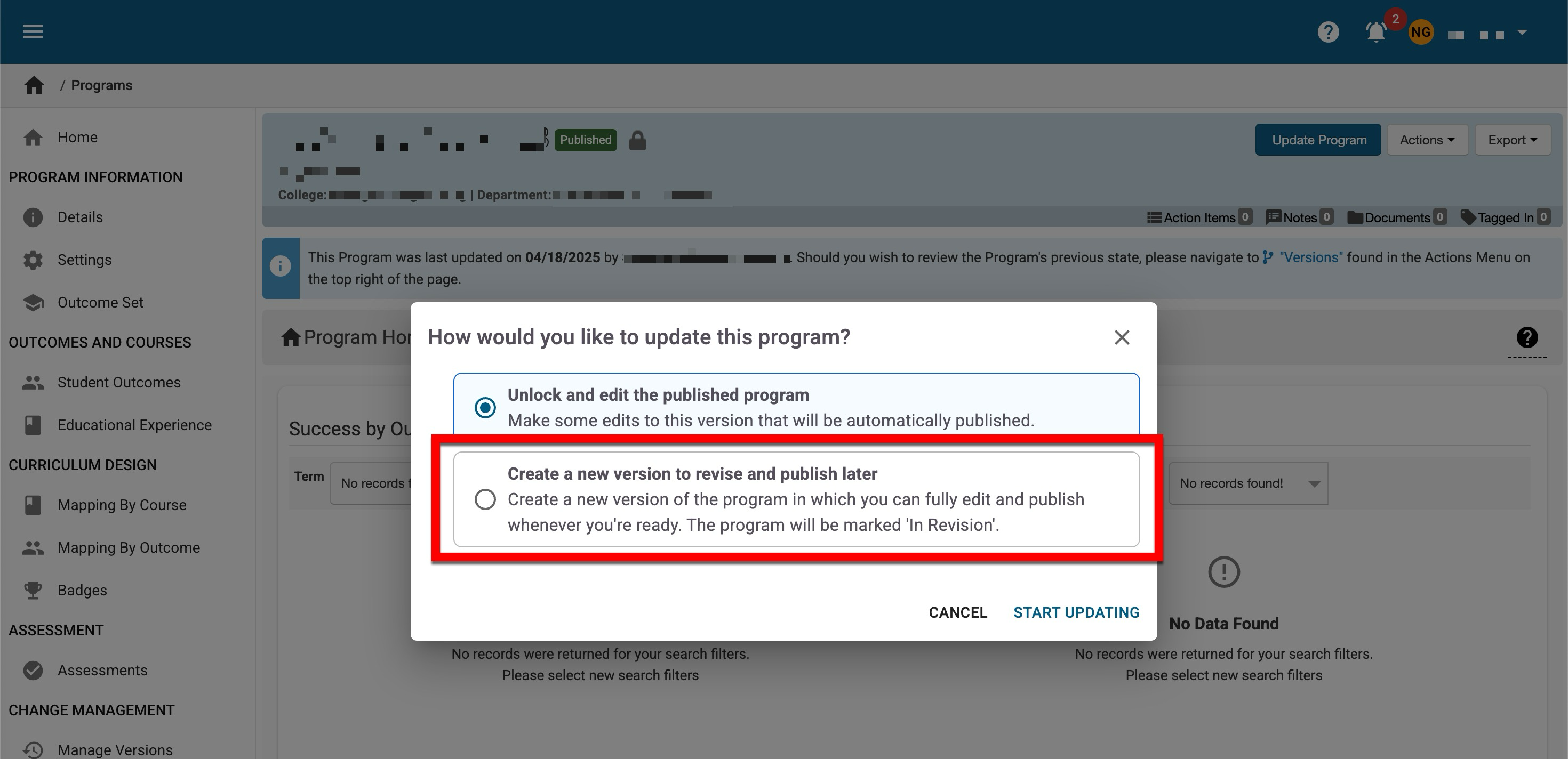
-
Once revised, the homepage will display that a published version is available, along with the date it was last edited. While in revision, all configurations of the program can be edited.
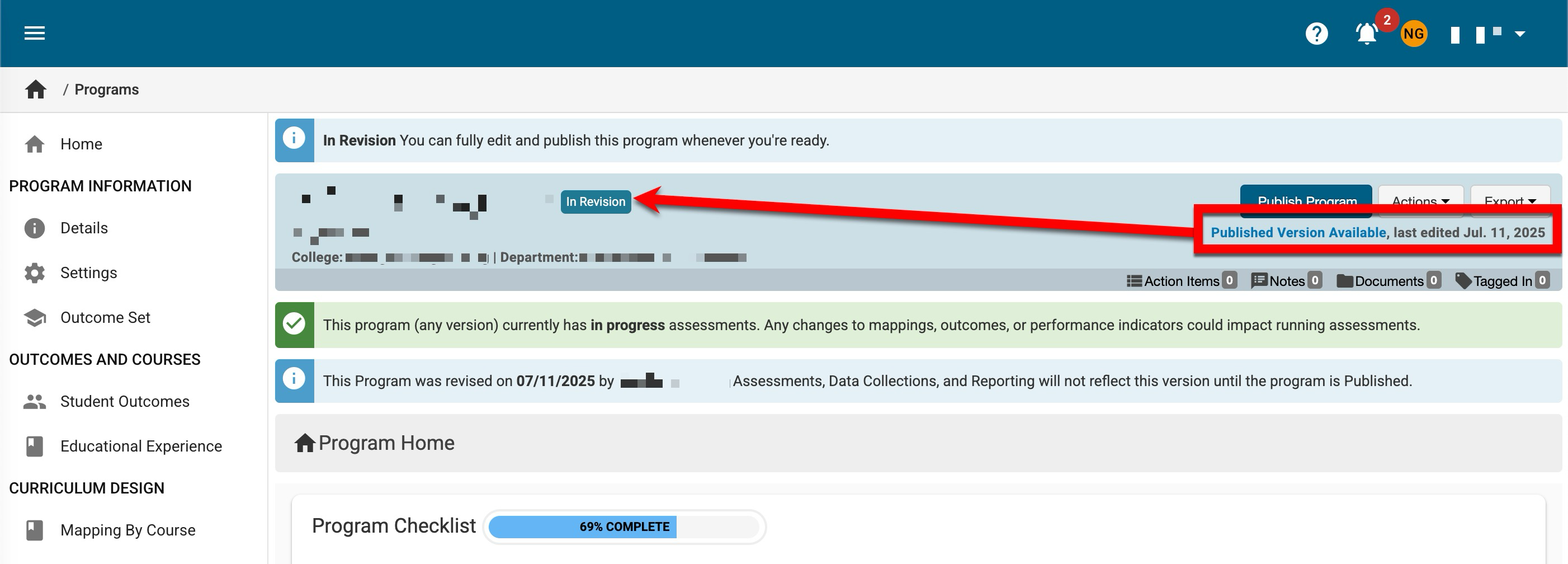
-
When revisions are complete, click Publish Program.
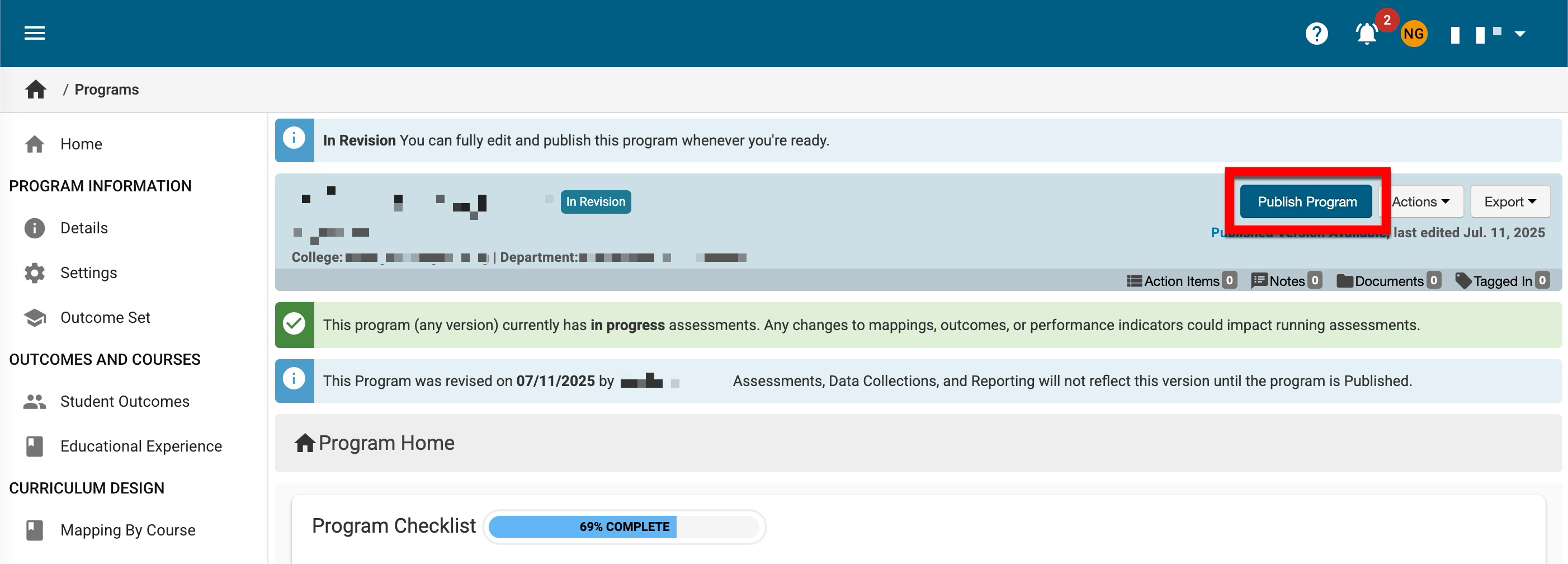
-
The revision log (1) will display the most recent edits performed before publishing. During publication, choose which terms the program revisions should apply to for Program Assessments (2). If completed terms are selected, Program Assessments for those terms will be reopened, and revisions will be applied. Those assessments will then automatically close on the current date, at midnight.
⚠️ When affecting in-progress or completed terms for Program Assessments, the new curriculum map will be applied upon publishing. This could mean that some course sections previously assessed may no longer be a part of the assessment. Additionally, curriculum mappings may be automatically removed or added to the course section assignment linking based on the new curriculum map. If any assessments in In Progress, Pending or Completed status are not selected, they will remain associated with the older program version and will continue using that version’s associated experiences and mappings. After revisions are published, it is impossible to update assessments in In Progress, Pending or Completed status to the newest version, without deleting and recreating the assessments.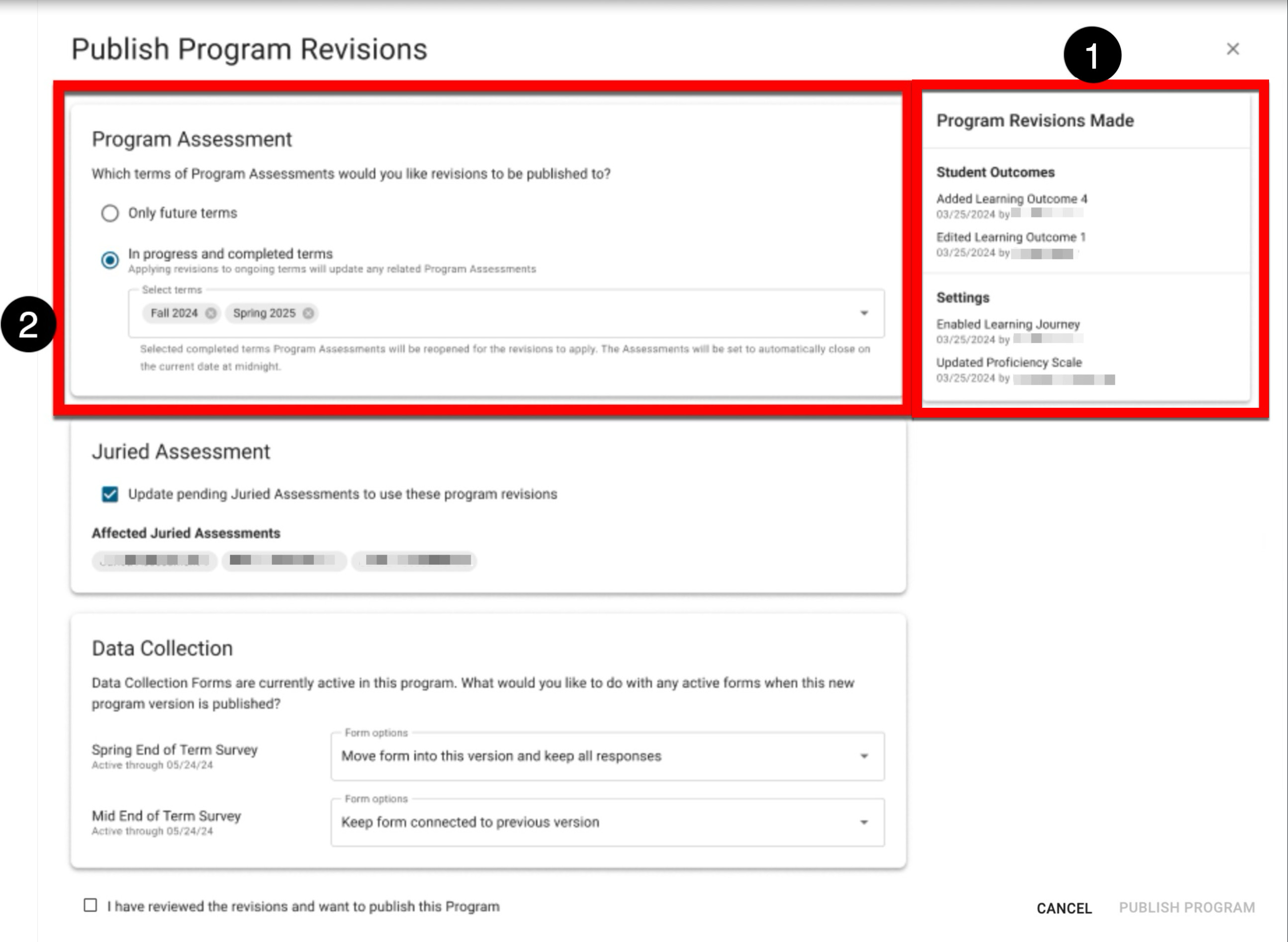
-
If Juried Assessment is enabled, the platform will automatically update pending Juried Assessments with the revisions. This should be disabled if historical versions of the assessments should be retained.
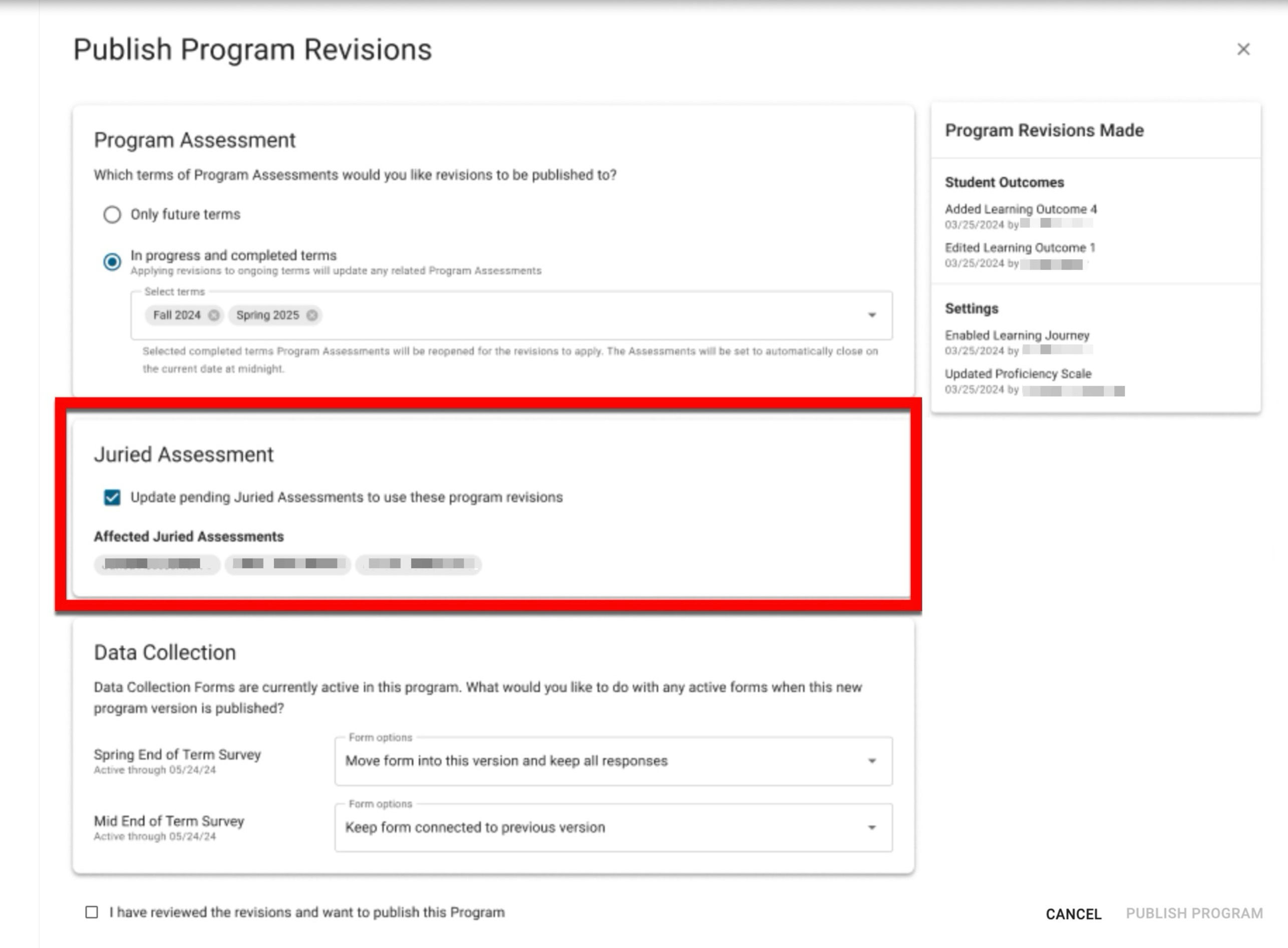
-
-
Additionally, the handling of active data collections can be configured
-
Keep the Form Connected to the Previous Version: Data collection forms will remain unaffected after publication.
-
Update the Form to This Version and Keep All Responses: Data collection forms will be updated to the new version of the program, and all historical responses will be retained.
-
Update the Form to This Version and Delete All Responses: Data collection forms will be updated to the new version of the program, and all historical responses will be deleted.
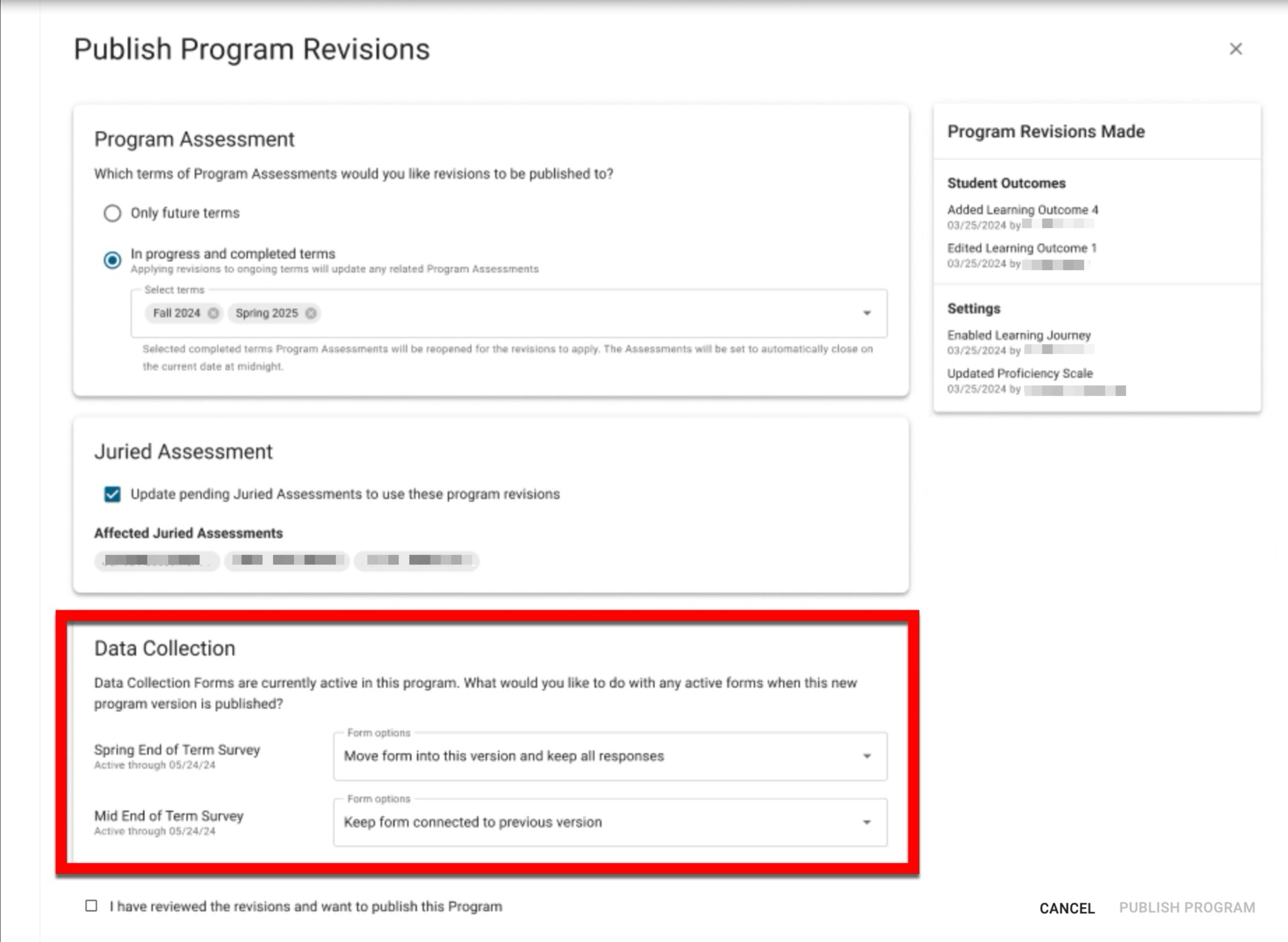
-
-
Once confirmation is provided (1), click Publish Program (2).
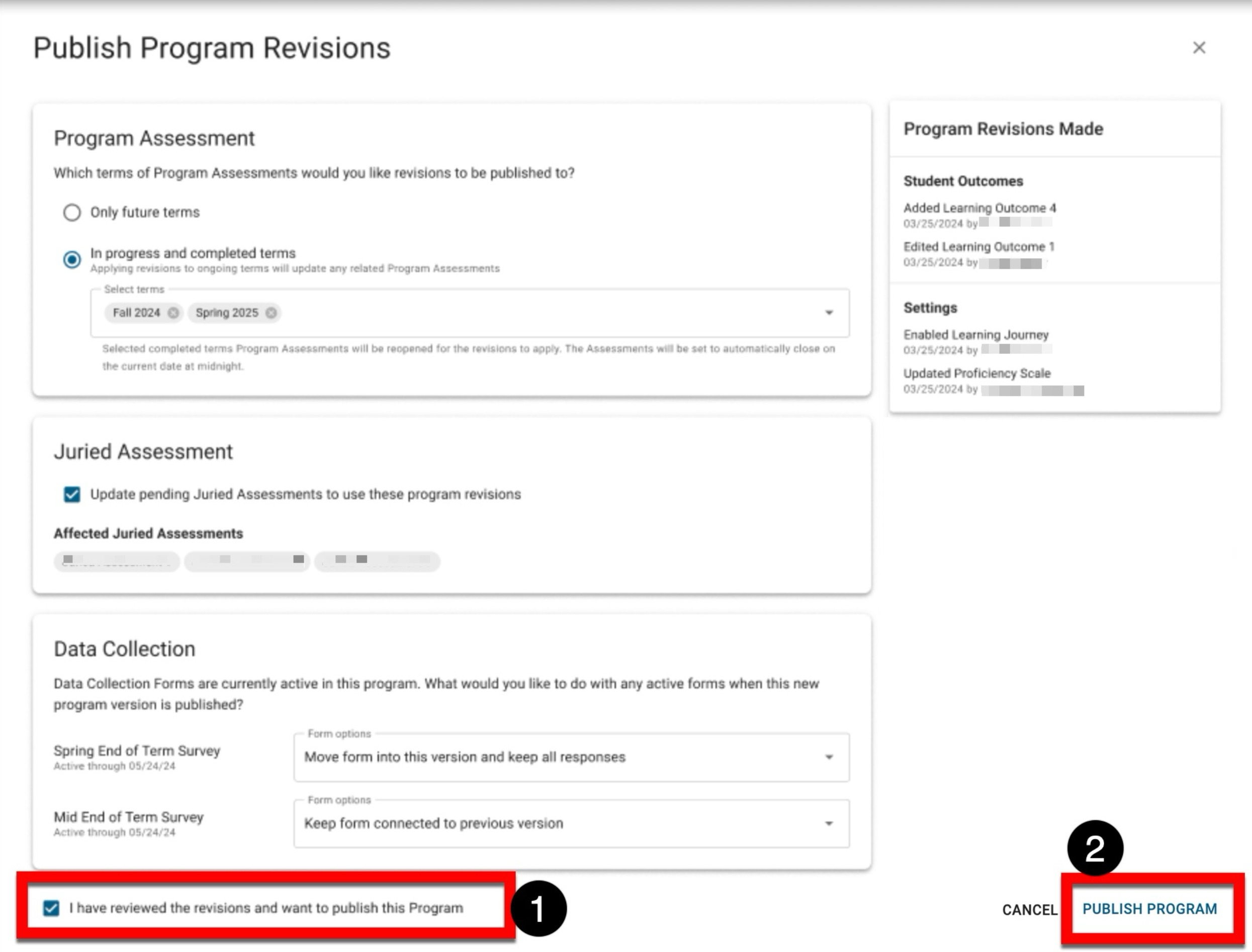
📔 Additional Resources
Editing a Program
